Disclaimer:
I do not intend to speak on behalf of Azamara Club Cruises. As an employee of Azamara Club Cruises, I hereby state that all views and expressions of opinion I hold are solely my own, and do not reflect or represent the views, values, beliefs, opinions, or company policies of ether Azamara Club Cruises or Royal Caribbean Cruises Ltd.
Additionally I neither own nor claim any legal rights to the links provided in this post.
Additionally I neither own nor claim any legal rights to the links provided in this post.
Ready? Here it is.

Well, ok; at first glance this shot of St. Petersburg isn't much to look at. It was taken from the top deck
of the ship, overlooking the Neva River. Most ships must dock quite far from the city centre. Our ship is small enough to sail right
up the river and is able to dock along the downtown riverside. This gives its passengers a walker’s
distance to some of the most renowned historical landmarks in St.
Petersburg.
Five of those landmarks are shown in this photo:
But
of course, it doesn’t do to just see these things from a distance, especially
when you may be viewing this photo from something as small as your
smartphone. I have a shot taken at
maximum zoom for each place.
This is a city that has seen so
much since its birth. From a
swampland to a sprawling aristocratic, military, and political center, St.
Petersburg has seen it all and then some.
The city was founded in 1703, so it is relatively young compared with
other European cities. But still
it is a city that has gone through intense changes and rich history. It was the capital of Russia from the
reign of Peter The Great until 1917.
Its name was changed to Petrograd at the start of WWI, and when the
country was known as the U.S.S.R. the city was known as Leningrad. The oppressed masses seethed here, and
finally they exploded in revolution and overtook the city in 1917. Power struggles ensued and finally the
Bolsheviks took hold of Russia. In
WWII, the Nazis starved this city to its knees, but it held fast, and was never
taken. All throughout the Soviet
era, the city—again, at that time called Leningrad—was a kind of liberal hotspot in the U.S.S.R., and was kept under Moscow's suspicious eye. By
the 1970’s Leningrad boasted an underground community of artists, reformists,
and other people that the government would have considered “radical.”
The ship had been to St. Petersburg
quite a bit as of June 2015. It
docked there three times, and each time it stayed in port for at least two days
and a night. This gave us more
than ample time to discover the many fascinating things hidden within.
For this blog, I’m going to discuss
what you see in the photo above. Each
of these five places, from left to right.
Now, first up, on the very left, is the oldest structure in the city:
the Peter and Paul Fortress.
Peter
The Great founded St. Petersburg in 1703. Peter And Paul Fortress was erected within a year of the city’s
founding. Thus it is the oldest
structure in St. Petersburg.
Peter
The Great was involved in The Great Northern War (1700-1721) at the time. Very boldly, he selected the recently
conquered territory at the mouth of the Neva River to be the site of St.
Petersburg. This territory had once belonged to Sweden. Oddly enough, the fortress never had to
be used to defend the city.
However, instead of becoming a defense for the city, the fortress became one of the most feared and infamous prisons of the Russian Empire. Even in the recent years following its erection, Peter and Paul Fortress became notorious. Many who went in never came back out. If they did, it was through this door:
When prisoners were taken out of the prison from this door, it meant they were being taken to their execution. Over the decades, Peter and Paul Fortress held many political prisoners, including Fyodor Dostoevsky and Lenin’s brother, Alexander Ulianov. And, according to certain accounts, Peter The Great’s rebellious son, Alexei, was one of the first prisoners. Apparently he was tortured to death within its walls.
The
first building to be erected within the fortress was the Cathedral of St. Peter
and Paul, shown in the pictures above.
After the television tower, the church is the highest point in the
city. Peter The Great wished for
the church to be influenced in the style of the Western European Protestant
churches: the spire and the bell tower are clear examples of this. And the inside? Well, it’s breathtaking:
There
is much to take in here. The last
three pictures are of the iconostasis; one of the largest I’ve seen, certainly. It is much taller in person, hence the
reason I had to take three shots to get it all.
To me, the most amazing thing about this place is that almost the whole royal family is buried here, including Peter The Great himself.
To me, the most amazing thing about this place is that almost the whole royal family is buried here, including Peter The Great himself.
Other
rulers buried here include Alexander I, II, and III, Catherine I and Catherine
The Great, Nicholas I and II, Elizabeth, Paul, Peter III, and Anne.
Only after I had forced myself (it
was hard to do) to turn away from Peter The Great's grave—being
next to these great figures in world history created an incredible magnetism—did I realize there were many more
coffins.
Even more moving, and sad, was to
see the remains of Nicholas II, the last Tsar, and his family.
They rest in the Chapel of St. Catherine. Their end was tragic and brutal. In 1917, when the Revolution was peaking, Nicholas II and his family were taken to a location in the center of Russia, and all were killed at once by a firing squad. The youngest and only boy in the family, Alexei, was not spared. Rumors have it that Anastasia, the youngest daughter, somehow survived the shooting and played dead, then escaped and went into hiding. But this is not the case.
This whole church became
surreal. I felt lost, a black
speck amongst an enormity of white, an ant skittering on top of a mountain of
decades and tumult and triumph and failure.
Peter and Paul Fortress became one
of the most powerful landmarks for me after our guide told us a story about her
school years. She was probably in
her late sixties-early seventies.
When she was 11 or 12 years old, the school had brought in a lecturer who
was considered a hero. He thought
himself a hero, too. Indeed, he
was actually one of the murderers of Nicholas II and his family! This man had been there that night,
helping to kill them all…. As of
today, Russia has since revoked any notion of “heroism” for these murders and
has labeled them as crimes.
It’s strange to think that a place,
which holds the remains of the royal family, also held political prisoners—the
“enemies”—of the royal family.
Those prisoners had been waiting to die. The royal family lies there, dead. Interesting, all that tumultuous history in one place….
So, time to move right in our photo…
to
one of the most awe-inspiring landmarks
in St. Petersburg:
The
Hermitage Museum.
The Hermitage Museum is one of the
largest and most acclaimed museums in the world. Its collection boasts over three million works of art….
I’m not kidding. If one
were to see each work of art in the collection for one minute, it would take
eleven years…. That being said, everything to be seen in the museum
accounts for a roughly 5-10% of the entirety of the collection. The rest is kept in the Storage Facility in the north of the city.
 |
| Within Palace Square, outside the Hermitage |
 |
| From within the inner coutryard. |
The
Hermitage Museum is actually comprised of five buildings. Seen above are a few shots of The
Winter Palace, only one building of the five. The Winter Palace, originally built for Empress Elizabeth,
became the main residence of the Romanov Tsars from the 1760’s. Catherine The Great resided here after
Elizabeth’s sudden death.
The Winter Palace has 1,057
rooms…and all are lavishly, elaborately, and wonderfully decorated in
decadence. Utter decadence. Sometimes I found myself looking more at
the rooms than the artwork. Many of these rooms house artwork, and the other four buildings of the Hermitage
Museum hold artwork, too. That’s
how massive the art collection is; everything from ancient Egypt to the early
20th Century….
Well…I think it’s time for a tour of what I saw.
NOTE:
There are many pictures coming up. At the expense of making this blog very, very long, I desire more to show the scope of what I saw in the Hermitage to the fullest extent. So, bear in mind that what I saw was a mere fraction of the entirety of the museum.
 |
| The main entrance hall of the Hermitage. |
 |
| The old waiting room, for those dignitaries and other VIP's whom would visit the Winter Palace. |
 |
| And, in the waiting hall hangs a 6-ton chandelier. |
 |
| One of many rooms housing many paintings. This room is adjacent to the throne room. |
 |
| ...and this is the throne room. |
 |
| Read and then view the hall in the next few photos. |
 |
| This is a wondrous piece of decorative machinery called the Peacock Clock. It moves and spreads its wings with changes in time. |
 |
| Behind me was an exhibition hall full of fantastic original paintings by Rembrandt and his students. |
 |
| One painting of Rembrandt's: "The Return Of The Prodigal Son" |
 |
| A small room with the 60th or 70th chandelier that I'd seen so far. |
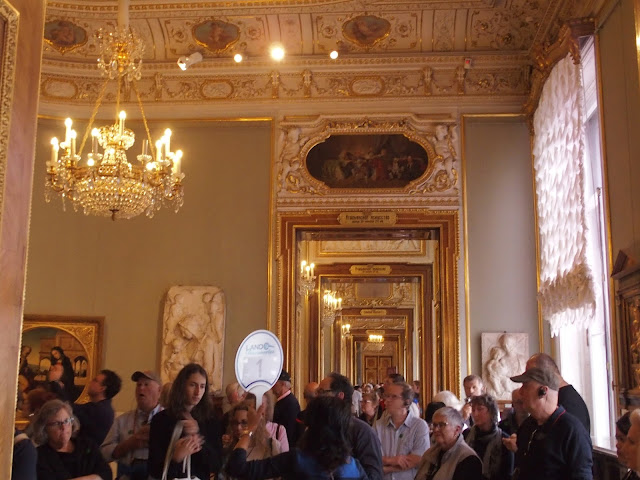 |
| A main hallway of the Winter Palace...look at all those rooms we'd passed.... |
 |
| The ceiling of one of my favorite rooms, which holds two paintings of Leonardo Da Vinci. |
 |
| One of my favorite rooms, which holds two paintings of Leonardo Da Vinci. |
 |
| A sculpture within the same room. |
 |
| Fine dishes, glasses, and containers in one of the hallways. Many of the hallways contained cases, each displaying anywhere from seven-fifteen or sixteen pieces of smaller arts and crafts. |
 |
| All shots of this gorgeous room were blurry...but this was the closest "clear" shot I could achieve. |
 |
| Another main hallway. |
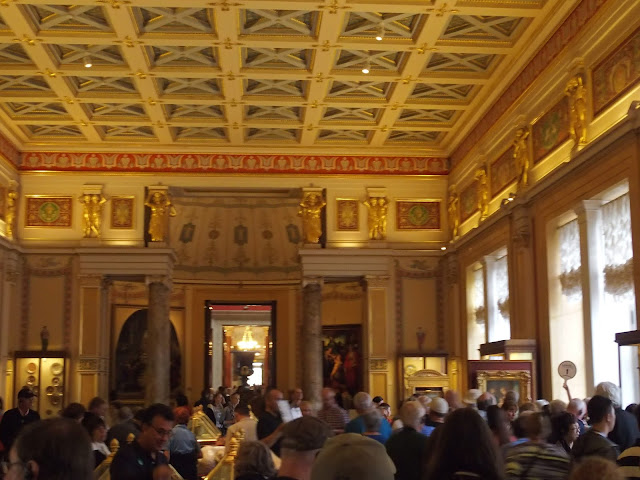 |
| A large exhibition hall. |
 |
| "Crouching Boy," by Michelangelo. |
 |
| A hallway full of sculptures. |
 |
| An incredible room of (if I remember correctly) Spanish paintings. |
 |
| An armory of medieval suits and weapons |
 |
| An additional room of Spanish painters and their paintings (again, if I remember correctly). |
 |
| A room of sculptures... |
 |
| And its partner room, down the stairs. |
 |
| Ancient Roman artwork |
 |
| I really wanted to spend time here, but we had to walk through the Ancient Egyptian room.... |
And that concludes all that I saw, more or less, of the Hermitage.
When one sees buildings like The
Winter Palace, one immediately thinks of a Western European influence. Indeed, the architecture is a stunning
example of the Baroque era. Not only that; today it stands as a testament not only to the outrageous wealth of the Russian Tsars, but also to world history and culture through the centuries. Catherine The Great was obsessed with collecting art; yet if it weren't for that excessive spending, the world would not have had access to one of the largest collections of art ever assembled and preserved.
I'll finish this section with a great moment in time for me: Buddhist monks, walking through Palace Square, past a roller-blading course.
When worlds collide, man!
It was pretty funny, in a great, multi-cultural way.
I'll finish this section with a great moment in time for me: Buddhist monks, walking through Palace Square, past a roller-blading course.
When worlds collide, man!
It was pretty funny, in a great, multi-cultural way.
More
information about the Hermitage can be found here: Saint-Petersburg.com is generally a great site with trusted and accurate information. There are other pages provided for detailed information about different parts of the museum and its history.
Now, back to our main photo, moving right from the Hermitage. We'll skip the gold spire for now, because I could not get a good, clear shot of it!
I also want to skip the spire to make this point: Peter The Great had large, grand visions for the city that was to be his capital. He had set forth many changes in Russia, and these changes were mainly influenced by Western Europe. Even to this day some Russians don’t completely agree with the fact that Peter The Great abandoned traditional Russian culture and architecture for more traditionally European influences.
However, this next landmark was
built in the traditional Russian style.
Along with the Hermitage, it is among the most iconic places in the
city.
Beneath this church lies the spot
upon which Alexander II, a Tsar of Russia, was assassinated. Alexander III, his son, wished for his
father to be remembered and revered, so he ordered the construction of this
church. Alexander II instituted
many reforms for Russia. Of great
significance was his freeing of the serfs, or working-class peasants, in
1861. Before then, these people
were practically slaves to their masters.
The lives of the serfs arguably did not change much after their freedom
was granted; they were still considered, and treated like, lowly people in the
society. Alexander II also
instigated major military, urban, and judicial reforms. Essentially, he set many major
precedents for Russia and Russian life.
Thus it was that his son saw it fit for a great monument to be built
around the place on which his father’s life was taken.
The construction was a huge feat, mostly
funded by the royal family and supplemented by many private donors.
It isn’t only the outside that captures us with its many mosaics and brilliant onion domes. Once I walked inside, I was blown away.
It isn’t only the outside that captures us with its many mosaics and brilliant onion domes. Once I walked inside, I was blown away.
Mosaics. Everywhere. All that is seen is mosaic. The pillars, the ceiling, and of
course, the portraits. It is no
wonder that the Church of Spilled Blood took twenty-six years to complete….
Some of the most celebrated Russian
artists of the day were brought in to craft what you see. All together, inside and out, the
church sports roughly 7,500 square meters of mosaics…arguably more than any
other church in the world.
And this, shown above, is where
Alexander II was assassinated.
Right underneath this canopy.
Mind you, the church is a huge tourist attraction, so I got lucky
getting these shots through all the heads in the crowd.
Once again, Russian royal history
had its glorious grip on me. I
never thought I would see such use of mosaics over the entirety of such a large
interior. It’s truly staggering. There’s the overall beauty to take in,
but to know the detail of it makes
that beauty almost ridiculous!
There must be a million or more tiles covering the interior! 7,500 square meters…but numbers don’t matter
at a place like this. It’s the
sheer bombardment of our perceptions; the way the place fills our perceptions
up to the brink in an instant. And
we stay full, overflowing with it.
The world is not full of things that can do this to us so effectively. Several of those things, however, can
be found in St. Petersburg: The Hermitage, Catherine Palace, The Church of
Spilled Blood, and St. Isaac’s Cathedral, to name a few….
I believe the guide wanted to move
us along. This site is a favorite
for pickpockets and thieves, so one needs to be extra cautious when waiting in
line or taking pictures. Nevertheless,
like the Hermitage it is a must-see.
This site gives a great description
and more info about the Church Of Spilled Blood, as well as access to many
other sources and information regarding St. Petersburg and Russia in general.
This next link gives more
information as to how and why Alexander II was assassinated, and the history of
his rule. The main site generally
has great information, and I found its accuracy of info to be favorable.
Now, let’s go back to our main shot:
Maybe you didn’t notice this spire--on the very left--the first time you saw the picture! But I will mention it briefly since it is rather imposing on the skyline. Apologies for the rough subject angle, but throughout my photos I could not find one (taken from the ship) that focused on the spire as a primary subject.
This is The Admiralty.
 |
| The Admiralty with The Bronze Horseman in front. The Bronze Horseman is a statue of Peter The Great. |
A
gigantic building that spans several city blocks, the Admiralty, like Peter and
Paul Fortress across the river, is one of the oldest structures in the
city. What you see today is not
the original. At first, it was a
fortified shipyard. Ship-building
in this area began in 1704-1706.
Peter The Great himself was an expert on ship-building, ship-design, and
carpentry, and he often worked alongside those in the shipyard. Russia had only one seaport in the 18th
Century, and Peter The Great was adamant about building a mighty navy. It was by his decree that the Admiralty
came into being, and from 1704-1844 the Admiralty saw about 262 warships come
out of its docks.
In
1719 the stone building was added, along with its iconic Admiralty Spire. The rest of the 400m façade that we see
today was built over the course of seventeen years. 1823 was the year that saw the completion of this
extraordinary piece of architecture.
Famed Russian architect Adrian Zakharov headed the project. He redesigned the structure in the
classic Russian-Empire style while still retaining some Neo-classical
elements.
After
1844, the Admiralty became the central point of several naval
institutions. From 1925 to the
present day, the Admiralty houses the Dzerzhinsky Higher Naval College.
Though
I’ve never been inside the premises, I have certainly admired the Admiralty
during my day-stays in St. Petersburg:
 |
| A statue of Nicholas I; notice the helicopter over the spire, too! |
These last few photos were taken on
a cloudy summer day from the garden just outside the main entrance of the
spire. It’s called Alexandrovsky
Garden; if you’ve got time, it’s a wonderful place to walk through. The Admiralty’s façade, all 400m of it,
faces this garden. It really is a
beautiful place.
At the time, I had no idea that the
Admiralty was so huge. It wasn’t
until I researched it that I realized what I was seeing was one single
structure! Of the several times I
had walked the blocks that the Admiralty dominates, I had always noticed
“separate” buildings, or at least separate businesses and institutions. But from an aerial view, it all makes
sense! The scope and size of this
building are amazing.
The golden spire, the Admiralty
Spire, has been a significant icon of the city since the 18th
Century. Take a closer look at the photo though; notice how there are three long roads stretching from the
spire’s focal point. These are
actually three of the main avenues of St. Petersburg: Nevsky Prospekt, Gorokhovaia
Street, and Vosnesensky Prospekt.
For us tourists, this spire is the
best landmark to remember. These three avenues are the hub for
discovering the city and most of its landmarks. You can travel any of these avenues quite a ways and still
be able to spot the spire! The streets
may be confusing, but if for some reason you have no access to a map, look for
the spire. You will be fine.
We have reached the final—or most-right-in-the-photo—landmark! The one that you had probably noticed
at first, because it is the most prominently shown:
This enormity of glory and awe, towering into the sky, is St. Isaac’s Cathedral. Its majesty and massive impression are not only hard to miss, but hard to forget.
The pure-golden dome (yes, real
gold) can be seen from all around the downtown area of St. Petersburg. It is the fourth largest domed cathedral
in the world, after St. Peter’s in Rome, St. Paul’s in London, and Santa Maria
del Flore in Florence (called “Il Duomo” unofficially).
At one time, though, St. Isaac’s
had been the largest church in Russia. The history of the church is interesting, for it has gone
through several transformations since 1710. In that year Peter The Great had ordered a wooden church to
be built in honor of St. Issac of Dalmita. Peter found it fitting to name the church after St. Isaac,
because St. Isaac’s feast day falls on Peter The Great’s birthday, according to
the Orthodox calendar.
After this church was swept away by
an overflowing Neva river, another church was erected. But this stone church soon collapsed
due to shoddy foundations. In 1768
Catherine The Great ordered another church to be erected in honor of
Peter. This church was never
completed, and so finally in 1809, Alexander I held a nation-wide competition
for a brand new design for a church of St. Isaac. A French architect, Auguste Ricard du Montferrand, was given
the honor, and his design was monumental in scope.
It took forty years to complete the cathedral. Not only was it to be comprised of granite and marble, but
there were also grand, extravagant plans for the interior. First, Montferrand--using the same
technique as the Venetians did for their buildings--had 10,000 piles of wood driven
into the marshy ground. This
provided stability for the cathedral’s foundation. Entire forests were chopped down for this endeavor. Upon those pilings a layer of stone was
set. The site was now prepared for
the next thirty years, wherein roughly 300,000 tons of granite and marble were
assembled into the exterior of the church. Notable are the red granite Cornithian columns set up around
the exterior:
Each weighs 115 tons, reaches 60 ft high, and is 7 ft
wide.
The incredible dome is covered in 100kg—about 220 Ibs.—of
pure, gilded gold.
And, the great porticos over the entrances are masterfully
done:
In
1842 the exterior was completed, but it took sixteen more years to complete the
interior. Though I don't know from first-hand experience, the impact upon the senses must be near-unbelievable....
This site gives a look at the interior. It also goes into great detail about the cathedral's history.
It's a very good read.
And this site gives more of a summary upon the cathedral's history.
It certainly is so grandiose, so
magnificent, so emotionally stirring, so…MUCH…. Actually, speaking of “much:”
the cost of the cathedral, as can be deduced, was astronomical. It ended up being many times—roughly
six to ten times—more costly than the Winter Palace! Many kinds of marble, precious and semi-precious stones were
used for the interior’s decoration.
The most revered artists and sculptors of the day collaborated in the
effort to produce the most magnificent layouts, paintings, sculptures, and
mosaics.
I had not known--before seeing the
interior photos of St. Isaac’s Cathedral--that Russian royalty had gone to such
lengths to represent itself so ostentatiously…. That being said, I truly, truly wished I had made more of an effort to go inside the cathedral. Moreso than The Church of Spilled
Blood. Groundbreaking artistry can
be seen nearly everywhere within this cathedral, a place that can accommodate almost
14,000 standing patrons, has brilliant acoustics for performances, and reminds
us of the astounding ingenuity and the glorious power of human capability.
That being said, “human capability”
can be seen in either a wonderful or a harsh light, depending on what we’re
speaking of here. The serf class
mainly undertook the cathedral’s erection—and the erection of most of the
city’s old palaces, landmarks, cathedrals, and monuments. Though Alexander II abolished the serf
class and gave them their freedom in 1861, the newly freed serfs still had to
pay “redemptive fees” to their former masters and landlords. Serf lives did not change very much.
For those serfs who worked on St.
Isaac’s, life was often deadly. Hundreds
died from falls, or from being crushed.
Fumes from the gilding of the domes killed others. All those lives for an undertaking that some regarded as just an obscene representation of Russian wealth.
For those who would like to learn more:
This site has a good description of
peasant-serf life in old Russia, and boasts many links to scholarly journals
and the like.
But, it's this Lonely Planet piece that really goes all-out; it gives a sometimes-facetious but novel-like account of St. Petersburg’s
history. It’s definitely long, but absolutely worth the read. Within
you can
find much and more about what I’ve already mentioned.
On one hand, we see these
nearly-unbelievable palaces and monuments and cathedrals and think, “ohhhh
myyyyy….” On the other hand,
there’s the more insidious reality behind how these stupendous places came to
be. The peasant class in Russia
was exploited for centuries under a strict hierarchical social system with no
room for movement. And as the
power and wealth of the Russian royalty grew in St. Petersburg, so grew dissent
within the lower classes. They greatly outnumbered the nobility and the
royalty. Of course, as we know, the
masses eventually could not take it anymore….
I think St. Petersburg’s history
plays out much like an epic novel: how a swamp was gradually turned into
Russia’s new capital; how an older Russian culture was gradually replaced with
a new one, dominantly within the upper-class, that was soaked in European
flair; how betrothals, betrayals, and sudden deaths lead to rulers such as
Catherine the Great and Nicholas II; how the city mobilized itself so well to
fight the German siege in WWII; and how, during the Cold War, liberal, forward-thinking groups of
“radicals” stirred in St. Petersburg's underground scenes and communities. Things were a bit chaotic as the
country struggled to redefine itself after the fall of the U.S.S.R in
1991. But clearly, St. Petersburg
has bounced back, and for many years now it has been radiating with its influential,
dynamic, and awesome history.










































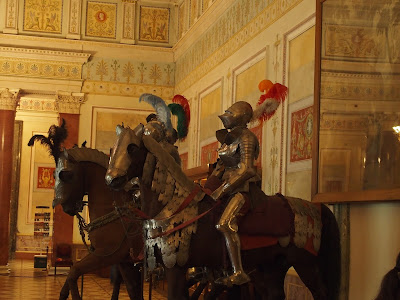

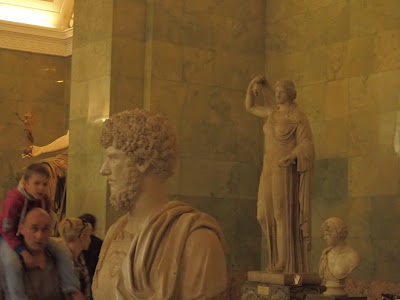


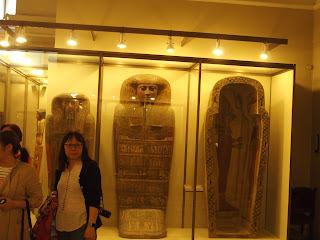








































No comments:
Post a Comment